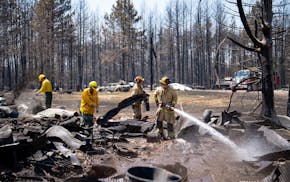Thousands of state employees will return to the office on Monday, some possibly for the first time since the pandemic hit in early 2020. Others gave up their home offices years ago and may barely notice the change, apart from fuller parking lots and cubicles.
Gov. Tim Walz has said the new policy, which says employees can work remotely only up to 50% of the time, strikes a balance between the flexibility of telework and the collaborative benefits of office work.
But the plan is also hugely controversial among the state's workforce and the unions that represent them. It's somewhat opaque, too, as many of the details will be hammered out by individual agencies and several declined interview requests.
We covered the basics of the policy when it was announced back in March. Here's what we've learned since then.
How many workers will be affected?
Lots of 'em. Not including college and university employees, about 40,000 people work for the state government. Of those, about 60% never stopped going to work during the pandemic because of the nature of their jobs, said Patrick Hogan, spokesman for Minnesota Management and Budget. That leaves about 16,000 employees who have teleworked over the past five years, though their in-office work varies greatly by agency and employee, he said.
"We don't have statistics regarding how many already were working at their primary workspace at least 50 percent of the time," Hogan said.
The policy also says agencies can allow workers who live more than 50 miles from their primary workplaces to telecommute more often — even up to 100% of the time. But at least one agency, the Department of Natural Resources, is capping telecommuting in such cases to 70%.
"We gave a lot of really careful thought to … how the policy intersected with our operations and business needs," said DNR Deputy Commissioner Barb Naramore.
Is there enough space for everyone?
Yes, there is, Walz has said publicly, though union leaders dispute that and some agencies have been granted temporary exemptions as they figure out logistics. Some agencies are embracing shared workstations to more efficiently use space.
The state is also dialing back its push to end leases and consolidate agencies into state-owned buildings, said Wayne Waslaski, an assistant commissioner at the Minnesota Department of Administration.
"There's going to be situations where we have to lease more space to accommodate the space need," he said.
Which agencies got exemptions from the policy?
The state granted exemptions to 12 agencies that said they couldn't meet the June 1 deadline because of space or equipment needs, Hogan said. The exemptions rage from mid-June to Sept. 2, he said, and generally apply to just a subset of the agency.
Waivers have been granted for some portion of these agencies:
- Children, Youth, and Families
- Commerce
- Corrections
- Direct Care and Treatment
- Health
- Human Services
- Management and Budget
- Minnesota IT
- MNsure
- Pollution Control Agency
- Revenue
- Veterans Affairs
The Department of Health's exemption will last longer than the others, Hogan said, because of a significant construction project underway. Agency call centers will also continue to telework for now, Hogan said.
What about parking for St. Paul workers?
Parking is in short supply on the Capitol complex. Long-term parking at state-owned ramps and lots is not available, though it was full before the pandemic, too, a Department of Administration spokesperson said. Wait lists are open. Other private options are available — especially across the freeway in downtown St. Paul — as is metered street parking.
The state also offers discounted public transit passes. Three Green Line stations serve the Capitol and nearby state office buildings, and Metro Transit this week announced an increase in police presence on that line in response to security fears.
Metro Transit's B Line, a new rapid bus line serving the busy Selby Avenue, Marshall Avenue and Lake Street corridor with a stop near the Capitol, launches in mid-June.
Still, given the car-centric nature of the Twin Cities and its suburbs, many state workers will likely choose to drive and pay for parking. Minnesota Association of Professional Employees President Megan Dayton called it a "thousand-dollar pay cut."
How much will return to office cost?
That's unclear.
Each agency is meeting the policy's requirements within their current budgets, a Department of Administration spokesperson said. Several agencies declined interview requests. The DNR's Naramore could not estimate costs but said they likely won't be significant.
"I'm not expecting a large bill," she said.

31 Palestinians are killed heading to a Gaza aid site, witnesses say. Israel denies responsibility
Amtrak's Borealis beat ridership expectations in first year. Minnesota wants to build on its success.

Hot, dry weather challenges wildfire suppression efforts in northeastern Minnesota
Two people injured in shooting outside University of Minnesota arena released from hospital

